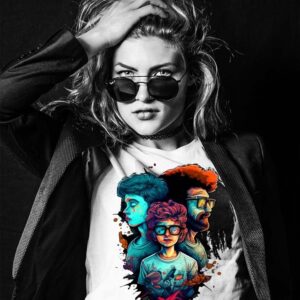





























In recent years, graphic printed tees have become an increasingly popular fashion statement. These tees allow individuals to express their unique personality and style through eye-catching designs. With the advancement of technology, specifically Artificial Intelligence (AI), the process of transforming digital designs into physical prints on t-shirts has become more efficient and accessible. In this article, we will explore the fascinating journey from pixels to prints, and how AI is revolutionizing the production of graphic tees.
Understanding AI and its Role in Graphic Tee Production
Artificial Intelligence, often referred to as AI, is a branch of computer science that focuses on creating smart machines capable of performing tasks that typically require human intelligence. AI algorithms can process and analyze large volumes of data, learn from patterns, and make predictions or decisions based on the acquired knowledge.
Regarding graphic tee production, AI plays a crucial role in transforming digital designs into physical prints. Traditionally, this process involved manual labor, with designers creating digital strategies that were then transferred onto screens for printing. This method was time-consuming and prone to human error.
With AI, the process has been streamlined and automated. AI algorithms can analyze digital designs, identify color schemes, optimize image resolution, and generate print-ready files. This eliminates manual intervention and significantly reduces production time, leading to faster turnaround times and improved efficiency.
The Journey from Digital Designs to Printable Formats
Step 1: Design Creation and Optimization
The first step in the journey from pixels to prints is creating and optimizing the digital design. Graphic designers use specialized software to create visually appealing designs that reflect the desired style and message. These designs are often created using vector-based graphics, allowing for scalability without losing quality.
Once the design is finalized, AI algorithms come into play. These algorithms analyze the structure, optimize color schemes, adjust resolution, and ensure the design is suitable for printing on a t-shirt. By automating this optimization process, AI helps designers save time and effort, ensuring the final design is print-ready.
Step 2: Color Separation and Halftoning
After the design is optimized, the next step is color separation. This process involves separating the design into different color layers, each representing a specific color that will be printed on the t-shirt. AI algorithms can accurately identify different colors within the design and create separate layers for each color.
Once the color separation is complete, the AI algorithms apply halftoning techniques to convert the continuous tones of the design into a series of dots of varying sizes. This process ensures that the invention can be accurately reproduced using limited ink colors. Halftoning is essential for achieving high-quality prints with smooth gradients and shading.
Step 3: Printing Preparation
With the design optimized and color separation complete, AI algorithms generate print-ready files that printing machines can directly use. These files contain all the necessary information, including color layers, dot patterns, and positioning.
AI algorithms also assist in selecting the appropriate printing technique based on the design and fabric type. For example, screen printing, direct-to-garment (DTG) printing, and sublimation printing each have their advantages and considerations. AI can analyze the design and fabric properties to recommend the most suitable printing method, ensuring optimal results.
Benefits of AI in Graphic Tee Production
The integration of AI in producing graphic tees offers several benefits for both designers and consumers. Let’s explore some of these advantages:
1. Increased Efficiency and Productivity
AI significantly improves efficiency and productivity by automating various stages of the production process. Designers can create and optimize designs faster while printing companies can reduce turnaround times. This increased efficiency allows for quicker delivery of graphic tees to customers, meeting their demands more effectively.
2. Enhanced Design Quality and Accuracy
AI algorithms excel at analyzing and optimizing digital designs. They can identify potential issues, such as low-resolution images or color inconsistencies, and suggest improvements. This ensures that the final print is of high quality and accurately represents the original design, meeting the expectations of both designers and customers.
3. Cost Reduction
With AI streamlining and automating various processes, production costs can be significantly reduced. Eliminating manual labor and the associated risks of errors and rework lead to cost savings for printing companies. These savings can be passed on to customers, making graphic tees more affordable and accessible.
4. Customization and Personalization
AI enables customization and personalization on a large scale. Designers can easily modify and adapt designs to meet individual customer preferences. Additionally, AI algorithms can analyze customer data and preferences to generate personalized design recommendations. This customization and personalization capability enhance the overall customer experience and satisfaction.
5. Sustainability and Waste Reduction
By optimizing designs and color separation, AI algorithms help reduce material waste during printing. This sustainable approach minimizes the environmental impact of graphic tee production. Furthermore, AI can analyze production data and identify areas for improvement, allowing printing companies to adopt more sustainable practices.
The Future of AI in Graphic Tee Production
As AI continues to advance, we can expect further improvements in producing graphic tees. Some potential future developments include:
1. Enhanced Design Assistance
AI algorithms can provide more comprehensive design assistance to graphic designers. By analyzing design trends, customer preferences, and market data, AI can generate design recommendations, suggest complementary color schemes, and even create new designs. This collaboration between humans and AI can result in innovative and captivating graphic tee designs.
2. Virtual Try-Ons and Augmented Reality Experiences
With the integration of AI and augmented reality (AR), customers may soon be able to virtually try on graphic tees before purchasing. AR technology can superimpose a chosen design onto a customer’s image, allowing them to visualize how the tee would look when worn. This interactive experience enhances the online shopping and helps customers make more informed decisions.
3. On-Demand Printing and Localized Production
AI can facilitate on-demand printing, enabling printing companies to produce graphic tees in response to real-time customer orders. This approach reduces the need for large-scale inventory and allows localized production, minimizing shipping distances and delivery times. On-demand printing also offers increased flexibility, as customers can request specific modifications or customizations to their orders.
4. AI-Generated Designs
In the future, AI algorithms can generate original designs independently. By learning from vast design databases, AI can analyze design trends, customer preferences, and market demands to create unique and appealing graphic tee designs. This AI-generated creativity can complement human designers’ work and lead to a broader range of customer design options.
Frequently Asked Questions (F.A.Q)
Testimonials
Conclusion
AI has revolutionized the journey from pixels to prints in the production of graphic tees. With its ability to optimize designs, automate color separation, and generate print-ready files, AI enhances efficiency, reduces costs, and improves design quality. We can expect further developments as AI advances, including enhanced design assistance, virtual try-ons, on-demand printing, and AI-generated designs. With the integration of AI, the future of graphic tee production is exciting, offering customization, sustainability, and innovative design possibilities. So, embrace the power of AI and express your unique style through a vibrant and personalized graphic tee.
For more information, visit Oglasee.
| From Pixels to Prints: How AI Transforms Digital Designs into T-Shirts |
| Introduction |
| Understanding AI and its Role in Graphic Tee Production |
| The Journey from Digital Designs to Printable Formats |
| Step 1: Design Creation and Optimization |
| Step 2: Color Separation and Halftoning |
| Step 3: Printing Preparation |
| Benefits of AI in Graphic Tee Production |
| Increased Efficiency and Productivity |
| Enhanced Design Quality and Accuracy |
| Cost Reduction |
| Customization and Personalization |
| Sustainability and Waste Reduction |
| The Future of AI in Graphic Tee Production |
| Enhanced Design Assistance |
| Virtual Try-Ons and Augmented Reality Experiences |
| On-Demand Printing and Localized Production |
| AI-Generated Designs |
| Frequently Asked Questions (F.A.Q) |
| Testimonials |
| Conclusion |